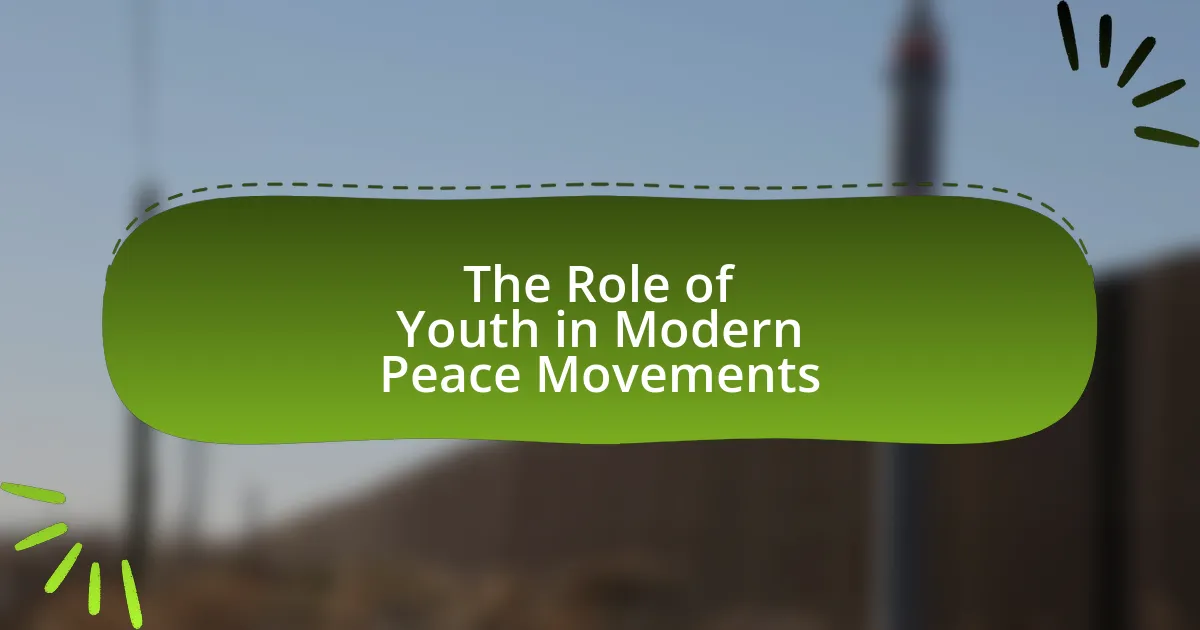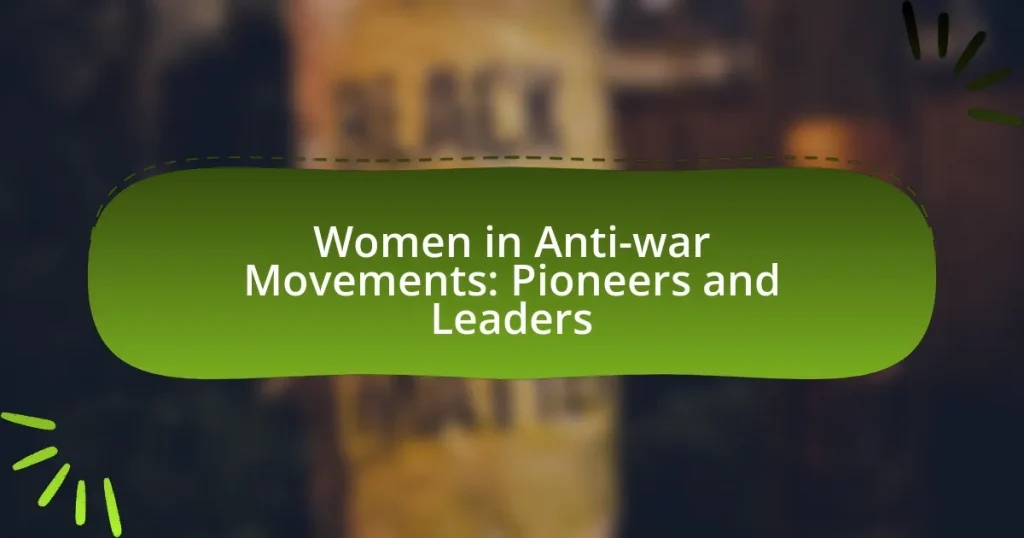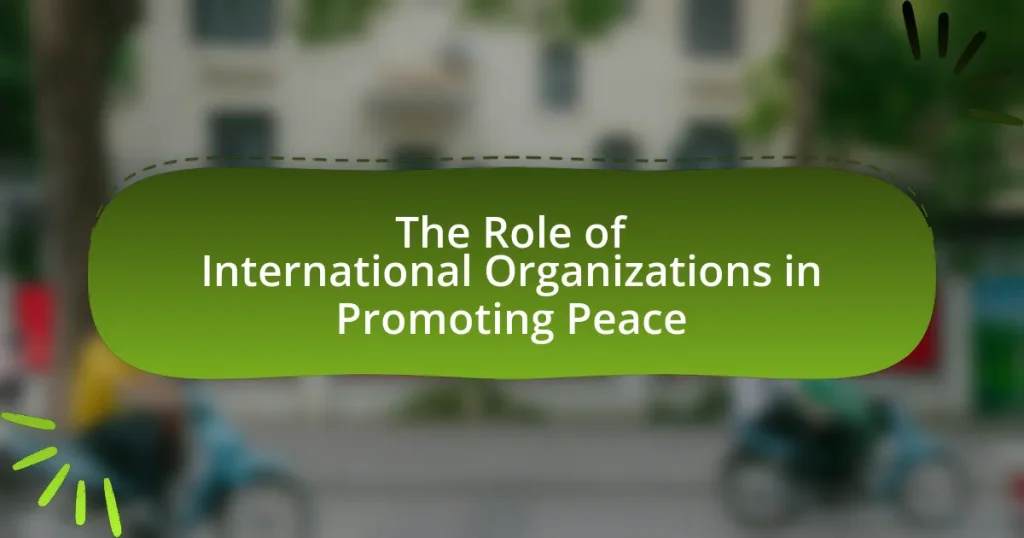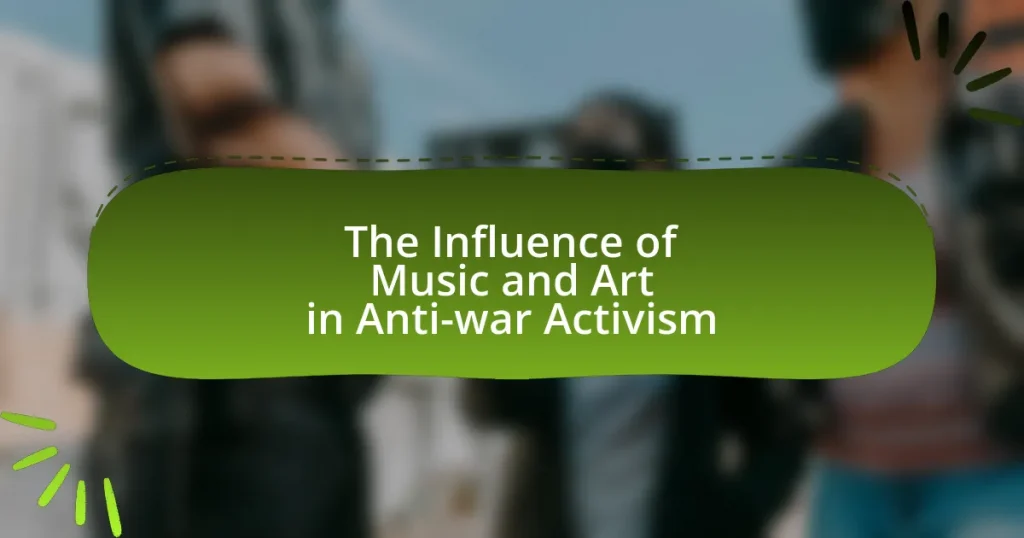The article examines the significant role of youth in modern peace movements, highlighting their contributions to activism, awareness-raising, and policy influence. It discusses historical contexts of youth involvement, key events that showcase their impact, and the evolving perception of young activists as vital agents of change. The article also addresses the challenges youth face in activism, the importance of technology and social media in amplifying their voices, and the future prospects for youth-led initiatives in promoting peace. Additionally, it emphasizes the need for educational support and collaboration with organizations to enhance youth engagement in peacebuilding efforts.
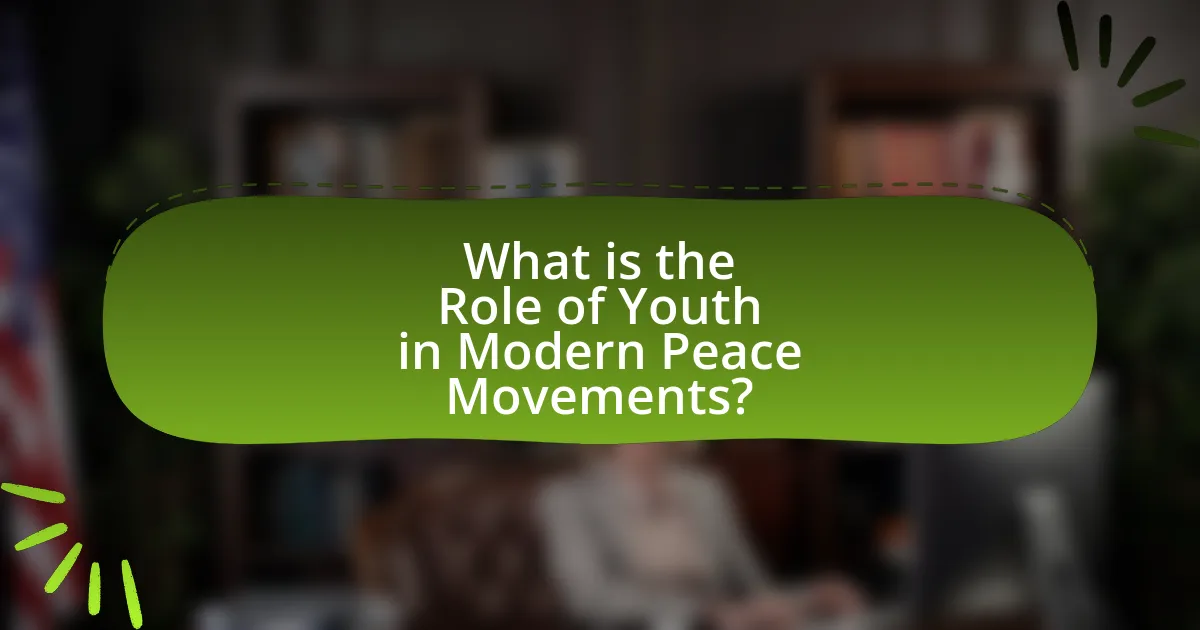
What is the Role of Youth in Modern Peace Movements?
Youth play a crucial role in modern peace movements by driving activism, raising awareness, and influencing policy changes. Their engagement is often characterized by innovative approaches, such as utilizing social media platforms to mobilize support and disseminate information rapidly. For instance, the global climate strikes led by youth activists like Greta Thunberg have highlighted the intersection of climate action and peace, demonstrating how young people can advocate for a more peaceful and sustainable world. Additionally, studies show that youth involvement in peace initiatives can lead to more inclusive and effective solutions, as they bring fresh perspectives and a sense of urgency to longstanding issues.
How have youth contributed to peace movements historically?
Youth have historically contributed to peace movements by mobilizing for social change, advocating for non-violence, and participating in protests. For instance, during the Vietnam War, young activists organized mass protests, significantly influencing public opinion and policy. The Student Nonviolent Coordinating Committee (SNCC) in the 1960s played a crucial role in the Civil Rights Movement, promoting peaceful demonstrations and sit-ins to combat racial injustice. Additionally, youth-led initiatives like the Global Climate Strikes have highlighted the intersection of peace and environmental issues, demonstrating that young people continue to be pivotal in advocating for a more peaceful and just world.
What key events highlight youth involvement in peace movements?
Key events that highlight youth involvement in peace movements include the 1960s anti-Vietnam War protests, where students organized mass demonstrations against U.S. military involvement, significantly influencing public opinion and policy. Another pivotal moment was the 2018 March for Our Lives, initiated by students from Stoneman Douglas High School in response to gun violence, which mobilized millions across the U.S. to advocate for stricter gun control laws. Additionally, the Fridays for Future movement, started by Greta Thunberg in 2018, showcases youth activism in addressing climate change as a peace issue, emphasizing the connection between environmental sustainability and global peace. These events demonstrate the critical role of youth in advocating for social justice and peace through organized activism and public engagement.
How has the perception of youth in peace movements evolved over time?
The perception of youth in peace movements has evolved from viewing them as naive idealists to recognizing them as vital agents of change. Historically, during the 1960s, youth were often seen as disruptive forces, primarily associated with protests against the Vietnam War. However, over time, particularly in the 21st century, youth have gained recognition for their organized efforts and innovative approaches to advocacy, as seen in movements like Fridays for Future and Black Lives Matter. These movements demonstrate that young people are not only passionate but also strategic in their activism, utilizing social media to mobilize and influence public opinion. This shift in perception is supported by studies indicating that youth engagement in social issues has increased significantly, with a 2020 Pew Research Center survey showing that 61% of young adults believe they can make a difference in their communities through activism.
Why is youth engagement crucial for modern peace movements?
Youth engagement is crucial for modern peace movements because young people bring fresh perspectives, innovative ideas, and a strong commitment to social change. Their active participation can mobilize communities, leverage social media for awareness, and inspire collective action. For instance, studies show that youth-led movements, such as the March for Our Lives, have significantly influenced public policy and raised awareness about gun violence in the United States. Additionally, the United Nations recognizes the importance of youth in peacebuilding, stating that their involvement is essential for sustainable development and conflict resolution.
What unique perspectives do young people bring to peace initiatives?
Young people bring innovative and fresh perspectives to peace initiatives, often characterized by their adaptability, creativity, and commitment to social justice. Their unique experiences in a rapidly changing world enable them to approach conflict resolution with new ideas and solutions that may not be considered by older generations. For instance, youth are more likely to leverage technology and social media to mobilize communities and raise awareness about peace issues, as evidenced by movements like the Arab Spring and global climate strikes, which were largely organized by young activists. Additionally, young people often prioritize inclusivity and diversity in peace processes, advocating for the voices of marginalized groups, which can lead to more comprehensive and sustainable peace agreements.
How does youth participation influence the effectiveness of peace movements?
Youth participation significantly enhances the effectiveness of peace movements by bringing fresh perspectives, energy, and innovative strategies. Engaging young people in peace initiatives often leads to increased mobilization and outreach, as evidenced by the global youth-led climate strikes that have successfully raised awareness about interconnected issues like climate change and social justice. Research from the United Nations indicates that youth involvement can lead to more inclusive dialogue and solutions, as young individuals often challenge traditional norms and advocate for change. Furthermore, studies show that when youth are actively involved, movements tend to gain greater visibility and support, ultimately leading to more impactful outcomes in promoting peace and social cohesion.
What challenges do youth face in participating in peace movements?
Youth face several challenges in participating in peace movements, including lack of resources, limited access to decision-making platforms, and societal apathy. These obstacles hinder their ability to mobilize effectively and advocate for change. For instance, many young individuals lack financial support and organizational infrastructure, which are crucial for sustaining activism. Additionally, youth often encounter barriers in being heard within established political systems, as their voices may be marginalized or dismissed. Research indicates that societal attitudes can also undermine youth engagement, with many adults perceiving young activists as inexperienced or naive, which can discourage participation.
What barriers limit youth involvement in peace activism?
Barriers that limit youth involvement in peace activism include lack of access to resources, limited awareness of issues, and societal perceptions that undervalue youth contributions. Research indicates that many young people face financial constraints that hinder their ability to participate in activism, as they often lack funding for travel, materials, or events. Additionally, a study by the United Nations Development Programme highlights that many youths are not adequately informed about peace issues, which diminishes their engagement. Furthermore, societal attitudes often dismiss youth voices, leading to a perception that their involvement is less impactful compared to older generations, which can discourage participation.
How can these challenges be overcome to enhance youth participation?
To enhance youth participation in modern peace movements, challenges can be overcome by implementing targeted educational programs that raise awareness about peace issues and empower youth with the skills needed for activism. Research indicates that youth engagement increases when they receive training in leadership, conflict resolution, and advocacy, as seen in initiatives like the United Nations’ Youth, Peace and Security Agenda, which emphasizes the importance of youth voices in peace processes. Additionally, creating inclusive platforms for dialogue and collaboration between youth and decision-makers fosters a sense of ownership and responsibility among young people, further encouraging their active involvement in peace movements.
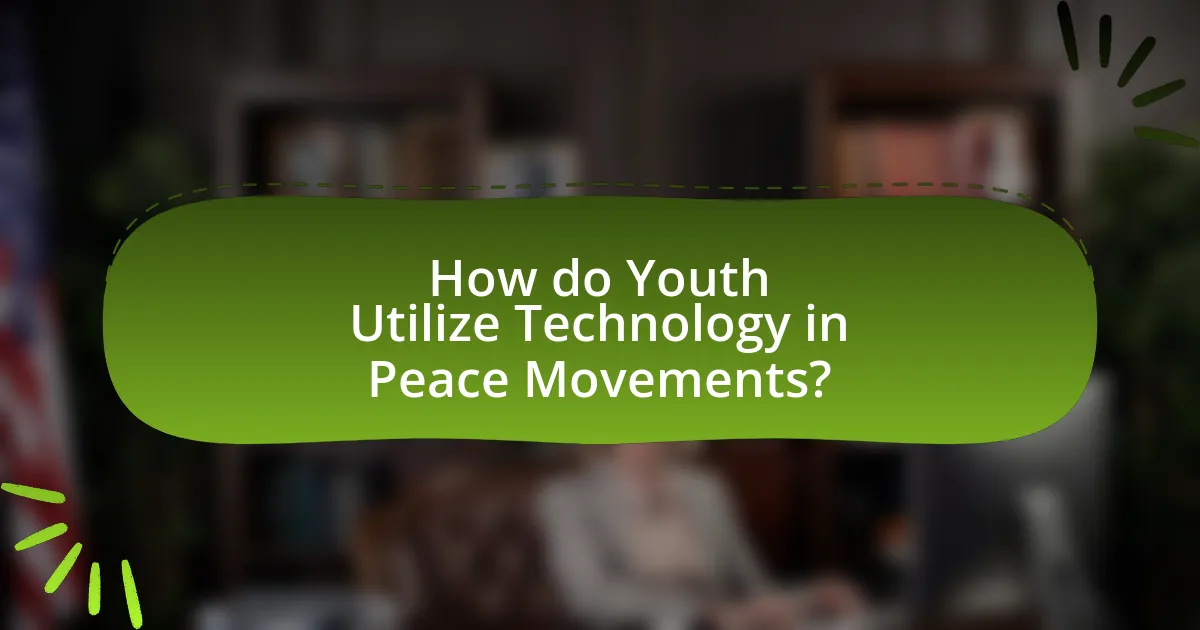
How do Youth Utilize Technology in Peace Movements?
Youth utilize technology in peace movements primarily through social media platforms, which enable them to organize, mobilize, and raise awareness about social issues. For instance, during the Arab Spring, youth effectively used Twitter and Facebook to coordinate protests and disseminate information rapidly, demonstrating the power of digital communication in grassroots activism. Additionally, platforms like Instagram and TikTok allow young activists to share compelling visual narratives that resonate with broader audiences, amplifying their messages and fostering community engagement. Research indicates that 70% of young people believe social media is a vital tool for social change, highlighting its significance in contemporary peace movements.
What role does social media play in youth-led peace initiatives?
Social media serves as a crucial platform for youth-led peace initiatives by facilitating communication, mobilization, and awareness-raising. It enables young activists to share their messages widely, connect with like-minded individuals, and organize events or campaigns efficiently. For instance, during the Arab Spring, social media was instrumental in coordinating protests and disseminating information, demonstrating its power in youth-led movements. Additionally, studies show that 70% of young people use social media to engage in social issues, highlighting its significance in fostering a sense of community and collective action among youth advocating for peace.
How do online platforms facilitate youth activism for peace?
Online platforms facilitate youth activism for peace by providing accessible communication channels that enable young people to organize, share information, and mobilize support for peace initiatives. These platforms, such as social media and dedicated activist websites, allow youth to connect with like-minded individuals globally, amplifying their voices and increasing the visibility of their causes. For instance, the #FridaysForFuture movement, initiated by youth climate activists, demonstrates how online platforms can effectively rally support and raise awareness about interconnected issues like climate change and peace. Research indicates that 70% of young activists use social media to engage in political discussions, highlighting the significant role these platforms play in fostering youth-led movements for peace.
What are the risks associated with using technology for peace movements?
The risks associated with using technology for peace movements include data privacy concerns, misinformation, and digital surveillance. Data privacy concerns arise when personal information of activists is collected and potentially misused, leading to threats against their safety. Misinformation can spread rapidly through social media platforms, undermining the credibility of peace movements and causing division among supporters. Digital surveillance by governments or hostile entities can lead to the identification and targeting of activists, which poses significant risks to their security and the overall effectiveness of the movement. For instance, a report by Privacy International highlights how governments have used technology to monitor and suppress dissent, illustrating the dangers faced by those involved in peace initiatives.
How can technology amplify youth voices in peace advocacy?
Technology amplifies youth voices in peace advocacy by providing platforms for expression, facilitating communication, and enabling mobilization. Social media platforms like Twitter and Instagram allow young advocates to share their messages widely, reaching global audiences instantly. For instance, the #FridaysForFuture movement, initiated by youth climate activists, demonstrates how digital tools can mobilize millions for a cause, showcasing the power of youth-led initiatives. Additionally, online petitions and crowdfunding platforms empower young people to organize campaigns and gather support efficiently, as seen in various youth-led peace initiatives that have successfully influenced policy changes. These technological advancements create an environment where youth can actively participate in peace advocacy, making their voices heard and driving social change.
What tools and resources are available for youth activists?
Youth activists have access to various tools and resources that empower their efforts in advocacy and social change. Digital platforms such as social media (e.g., Twitter, Instagram) enable youth to mobilize support, share information, and raise awareness on issues. Additionally, organizations like Amnesty International and the United Nations provide educational materials, training programs, and networking opportunities specifically designed for young activists. Research indicates that youth-led movements, such as the March for Our Lives, effectively utilize these resources to influence policy and public opinion, demonstrating the impact of organized youth activism.
How can youth leverage technology to mobilize support for peace?
Youth can leverage technology to mobilize support for peace by utilizing social media platforms to raise awareness and organize campaigns. For instance, platforms like Twitter and Instagram enable young activists to share information rapidly, engage with a global audience, and create viral movements, as seen in campaigns like #FridaysForFuture, which mobilized millions for climate action and peace initiatives. Additionally, youth can use online petitions and crowdfunding platforms to gather support and resources for peace projects, exemplified by initiatives like Change.org, which has facilitated numerous campaigns advocating for social justice and peace. These technological tools empower youth to connect, collaborate, and amplify their voices, effectively driving collective action for peace.

What are the Future Prospects for Youth in Peace Movements?
The future prospects for youth in peace movements are promising, as young people increasingly leverage technology and social media to advocate for peace and social justice. Youth engagement in movements such as Fridays for Future and Black Lives Matter demonstrates their ability to mobilize quickly and effectively, often leading to significant policy changes. According to a 2021 report by the United Nations, youth-led initiatives have been pivotal in addressing global issues like climate change and inequality, highlighting their potential to influence peacebuilding efforts. Furthermore, educational programs focused on conflict resolution and civic engagement are expanding, equipping youth with the skills necessary to lead peace movements in the future.
How can educational institutions support youth in peace activism?
Educational institutions can support youth in peace activism by integrating peace education into their curricula. This approach equips students with knowledge about conflict resolution, human rights, and social justice, fostering a culture of peace. Research indicates that programs focusing on peace education can significantly enhance students’ understanding of global issues and their role in activism, as demonstrated by the findings of the “Global Perspectives on Peace Education” study published by the University of Massachusetts, which showed that students engaged in peace education are more likely to participate in community activism. Additionally, schools can provide platforms for youth-led initiatives, such as clubs or events, that encourage dialogue and collaboration on peace-related issues, further empowering students to take action.
What programs can be implemented to foster peace education among youth?
Programs that can be implemented to foster peace education among youth include conflict resolution workshops, peer mediation initiatives, and community service projects focused on social justice. Conflict resolution workshops teach young people skills to manage disagreements constructively, while peer mediation initiatives empower students to resolve conflicts among themselves, promoting a culture of dialogue. Community service projects that address social justice issues help youth understand the root causes of conflict and the importance of empathy and cooperation. Research by the United Nations Educational, Scientific and Cultural Organization (UNESCO) highlights that such programs significantly enhance youth’s understanding of peace and conflict dynamics, fostering a generation committed to peaceful coexistence.
How can mentorship play a role in developing young peace leaders?
Mentorship is crucial in developing young peace leaders by providing guidance, support, and knowledge transfer from experienced individuals. Through mentorship, young leaders gain insights into conflict resolution, negotiation skills, and the importance of empathy, which are essential for effective peacebuilding. Research indicates that mentorship programs can enhance leadership skills and civic engagement among youth, as seen in initiatives like the United Nations’ Youth, Peace and Security Agenda, which emphasizes the role of mentorship in empowering young people to contribute to peace processes.
What strategies can youth adopt to sustain their involvement in peace movements?
Youth can sustain their involvement in peace movements by actively engaging in community organizing, utilizing social media for awareness, and participating in educational initiatives. Community organizing allows youth to mobilize local resources and build networks that amplify their voices and efforts. Social media serves as a powerful tool for reaching wider audiences, sharing information, and rallying support for peace initiatives, as evidenced by the success of campaigns like #BlackLivesMatter, which effectively utilized platforms to promote social justice. Educational initiatives, such as workshops and seminars, equip youth with the knowledge and skills necessary to advocate for peace, fostering a deeper understanding of conflict resolution and social issues. These strategies collectively empower youth to maintain their commitment to peace movements over time.
How can collaboration with other organizations enhance youth-led initiatives?
Collaboration with other organizations can enhance youth-led initiatives by providing access to additional resources, expertise, and networks. When youth organizations partner with established entities, they can leverage funding opportunities, gain mentorship, and benefit from shared knowledge, which can significantly amplify their impact. For instance, a study by the United Nations Development Programme highlights that collaborative efforts between youth groups and NGOs can lead to more effective advocacy campaigns, as seen in various global youth movements that successfully influenced policy changes. This synergy not only strengthens the initiatives but also fosters a sense of community and shared purpose among young leaders.
What best practices can youth follow to ensure impactful activism?
Youth can ensure impactful activism by engaging in informed advocacy, building coalitions, and utilizing digital platforms effectively. Informed advocacy involves researching issues thoroughly, understanding the historical context, and being aware of current events, which empowers youth to articulate their positions clearly and persuasively. Building coalitions with diverse groups enhances the reach and effectiveness of activism, as seen in movements like the March for Our Lives, which united students, parents, and educators to advocate for gun control. Utilizing digital platforms allows youth to mobilize support quickly and share their messages widely; for instance, social media campaigns have been pivotal in raising awareness and driving participation in various social movements. These practices collectively contribute to the effectiveness and sustainability of youth-led activism.
